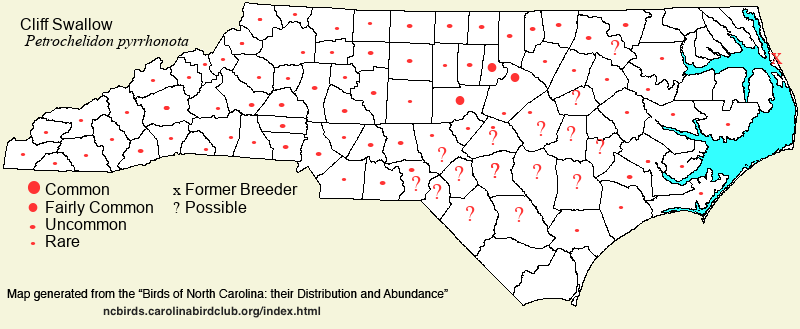 |  |
|
Cliff Swallow - Petrochelidon pyrrhonota HIRUNDINIDAE Members: | Search Common: Search Scientific: |
|
|
|||||||
| General Comments | The Cliff Swallow nests from coast to coast across the continent, and it is much more abundant in the Western states than in the East, because it traditionally preferred dry cliff habitats, often far from water. Because it does not have to nest in horizontal cavities, but it often builds a globular nest made of mud, plastered to a nook or crevice, it has adapted readily to man-made structures. In the East, essentially all nest sites are on man-made structures, usually under a bridge over an arm of a lake or over a river, or on a dam of such a lake; in some cases, they nest on the outsides of barns and other buildings. They also nest underneath bridges over other roads. Because of this adaptation to man, the Cliff Swallow range and abundance continues to expand in North Carolina -- it was completely absent as a breeder until the late 1960's -- and it now nests across much of the mountains and Piedmont, and very locally in the eastern Coastal Plain. When in the state, it is usually seen foraging over lakes/reservoirs, though a few sites are located away from water. Though the species departs the United States in winter, the state has one documented (with photos) winter record. | ||||||
| Breeding Status | Breeder | ||||||
| NC BRC List | Definitive | ||||||
| State Status | |||||||
| U.S. Status | |||||||
| State Rank | S4B | ||||||
| Global Rank | G5 | ||||||
| Coastal Plain | Transient, and very sparse and local breeder mostly near the coast; expanding its range in recent years and likely will be found breeding in more interior counties. Over the region as a whole, rare to uncommon spring migrant; and rare to uncommon over most of the region in fall, except uncommon toward the coast. Has nested (as of 2022) in Dare, Pamlico, Craven, Carteret, New Hanover, Onslow, and Pender, all close to tidal water; oddly, it perhaps has only been reported nesting farther inland in Pitt. Occurs primarily in May, and late Jul to early Sep. No records from Oct to mid-Nov; a report of one at Wrightsville Beach, by experienced observers, on 27 Nov 1959 may well have been correct, but in recent years, all Nov records refer to the very similar Cave Swallow (which was extremely rare in the United States in 1959). Absolutely remarkable was one photographed at Alligator River NWR on 4 Jan 2016 [Chat 80:90 link]. Another was very early on 12 Mar 2017 in Carteret. Peak counts: 155 nests at Havelock (Craven), 13 Jun 2014; about 140 nests where NC 101 crosses Core Creek (Carteret), 4 Jun 2018, and 125 active nests there on 21 Jun 2020; 98 nests at the Havelock site in 2009; 40 nests at the Trent River in New Bern (Craven), 10 Jun 2016. | ||||||
| Piedmont | Summer resident, with noticeable migratory movements; slightly increasing as a breeder. In summer (as a breeder), locally fairly common near reservoirs (such as Falls, Jordan, and Norman) and along some large rivers, but rare in many counties. Nests east to Roanoke Rapids Lake, Falls Lake, and under bridges over the Pee Dee River (Anson--Richmond). In migration, at best uncommon in both spring and fall. Mainly very late Apr to early Sep; promptly absent after Sep. One was remarkably late at Lake Brandt (Guilford) on 15 Nov 1997. Peak counts: 300, at an agricultural area in southeastern Union, 7 Aug 2023; 206, Jordan Lake spring count, 7 May 2000. | ||||||
| Mountains | Summer resident, with migratory movements. In summer (as a breeder), mostly uncommon and local; not widespread, as suitable large bodies of water are not numerous. Nests mostly under bridges over wide rivers, such as along the French Broad River. Rare to uncommon as a migrant. Mainly early May to late Aug or early Sep. Peak counts: 200, Hooper Lane (Henderson), 10-11 Sep 1997, an excellent count for so late in the season. | ||||||
| Finding Tips |
Though numerically not a common bird in the state, they are practically impossible to miss in May or Jun at colonies in the Piedmont, at reservoirs (stop close to bridges) such as Gaston, Falls, Jordan, etc., or under bridges over the Pee Dee or Yadkin rivers. **** | ||||||
| Attribution | LeGrand[2024-06-03], LeGrand[2024-02-10], LeGrand[2023-03-26] | ||||||
| NC Map Map depicts all counties with a report (transient or resident) for the species. | Click on county for list of all known species. |
| NC Breeding Season Map Map depicts assumed breeding season abundance for the species. |  |